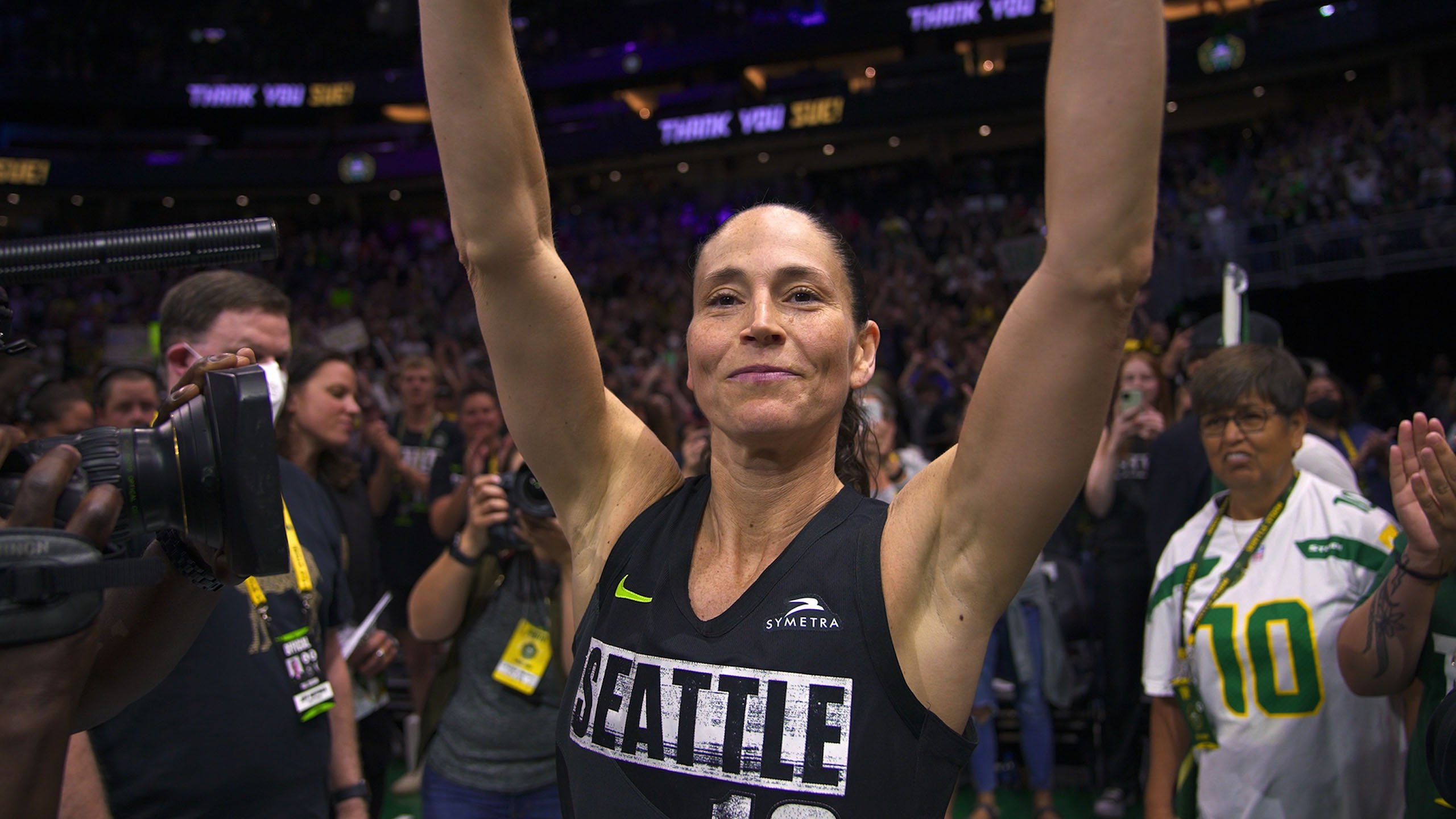Before I even knew how to read, my dad made sure I knew how to cheer for University of Connecticut basketball. That meant Suzanne Bird, who graduated from UConn in 2002 after an undefeated season, went on to join the WNBA and was a permanent fixture on the living room TV where my dad watched nearly every game. Anyone who followed college basketball in those years, or who has kept up with the WNBA since, likely had a similar experience: Bird was one of the most decorated and dominant players in the league, and the world.
So it was a thrill to see her again, this time 20 feet tall, when I attended the premiere of Sue Bird: In the Clutch at the Sundance Film Festival. The documentary, directed by Sarah Dowland, recaps and celebrates Bird’s gilded career, and is now available online to stream.
Guided by interviews with Bird’s parents, friends, coaches, teammates and fiancée (soccer player Megan Rapinoe), we first see Bird as a self-described “classic tomboy in the backyard,” transferring to Christ the King High School in Queens, New York, to follow her passion for basketball. Then we see her as a generational talent in her twenties, being drafted in the number-one slot by the Seattle Storm. She joins the WNBA when the percentage of sports media coverage dedicated to women’s sports in the U.S. is in the low single digits (to be clear, today’s 15 percent isn’t the stunning improvement one might hope for). And as a counterpoint to the footage of Bird’s continuing to grow on the court, we see a series of commercials from the early 2000s for, it seems, “women’s sports” as a concept. They feature Bird and other female athletes looking mostly uncomfortable in heels and lip gloss, reclining on the hoods of cars and posing suggestively—seemingly at the bequest of advertisers convinced that for women’s sports to be more profitable, the women in question needed to be more appealing to a straight male audience, regardless of their talents.
By the film’s end, we see Bird become the winner of four WNBA championships, five Olympic gold medals and too many other accolades to name—as well as a self-assured lesbian and advocate for equity in athletics. In the latter part of her career, we learn, Bird has pushed for better pay, more media coverage and stronger collective bargaining agreements for WNBA players. She also helped organize the WNBA’s racial justice activism, and joined a 2023 effort by 40 professional athletes to oppose a federal anti-trans sports ban. “The makeup of the WNBA is all the marginalized people in our world,” Bird points out while describing her pride in the league’s activism during the racial justice uprisings in 2020 and beyond.
The film is truly a love letter, both to Bird and to women’s basketball as a whole. And as is often the case with love letters, it sometimes falls into fawning rather than capturing the full complexity of Bird as a person. The things that one might imagine to be her greatest challenges—like the three surgeries she underwent between 2012 and 2014—are framed mainly as propelling forces for her later successes.
In 2009, Bird was playing basketball in Russia to supplement her low pay with the Storm and to stay in shape during the off-season, a common practice for WNBA players. The season was progressing according to plan—until her team’s owner, the concert promoter, businessman and convicted KGB spy Shabtai von Kalmanovic, was murdered. According to Bird, von Kalmanovic was hands-on with the team, lavishing them with gifts and attention. He seemed to view owning the Moscow Spartak as a true passion project, and based on reports at the time, he and Bird shared a close relationship. And yet, the film narrativizes his death more as a general shock, and a good reason to pay players well enough to stay in the U.S., rather than something that tore Bird’s life asunder in the way you might imagine. It’s apparent that she was sad. But how and whether that sadness impacted her—how she managed to suppress it or struggled to overcome it or simply found it easily surmountable—is less clear.
It’s not that bad things don’t happen to Bird, but rather that any and every setback is presented primarily as a container for a key lesson, or the set-up for an impressive rebound. It can be challenging to take inspiration from someone’s story, in the way that Bird and everyone involved in this project clearly hope viewers will, when they appear unaffected to an almost inhuman degree by the kinds of struggles that would sideline the rest of us.
“I hit a plateau in my career in my early to mid-30s,” Bird elaborated during a festival Q&A alongside the film’s executive producer, Jay Ellis, referencing the period of her surgeries. “But had that not happened, I wouldn’t have hired [my trainer] Susan Borchardt. I don’t think I would’ve played as long as I played, which means I don’t get two more WNBA championships and two more gold medals.”
Repeatedly throughout the film, those close to Bird describe her ability to simultaneously think on her feet and to see the long game, always while staying cool under pressure. From one perspective, the film’s framing gestures to the pressure placed on Bird to stay in control of all circumstances around her, a dynamic she says began with her coach at UConn, the notoriously tough Geno Auriemma. By the time this documentary was made, this kind of insistently, logistically optimistic framing seems to have been cemented into a Sue Bird trademark, perhaps one that was even key to her success as a point guard.
As a viewer, I can’t help but wonder if she has in some way traded one flattening role foisted upon her as a female athlete—that of the crowd-pleasing girl next door, forever toggling between “sexy” and “innocent” on the hood of that car—for another, a kind of preternaturally collected cool. Bird is a wildly impressive woman who has spent the lion’s share of her life so far in the spotlight (and, simultaneously, the closet). With this in mind, it’s not surprising that it can at times be hard to tell where the narratives being overlaid on her end, and her own crafting—whether it’s out of necessity, or habit, or true belief—begins.
One of the loveliest parts of the film is the freeness Bird feels when she talks about coming out publicly as an opportunity to come into her own. We’re treated to footage of Bird in vibrant blazers and baggy T-shirts, as she discusses the new ways of presenting herself that she felt able to explore after publicly sharing her sexuality. When asked what she’s gained since, Bird smiles. “Everything. Who I am now.”
“I didn’t know she was gay in college, but no one was gay in college,” says Diana Taurasi, Bird’s friend and former teammate in both Connecticut and Moscow.
“The minute I joined the WNBA, I felt really comfortable to be gay,” Bird says. She came out to family and loved ones in 2003, but said she didn’t see the need at the time to announce her sexuality to a wider audience. She began dating Rapinoe in 2016, who encouraged her to come out publicly so that she might serve as a role model for others.
Ultimately, the drive to illuminate a possible path for those coming up behind her is at the heart of Sue Bird: In the Clutch. And that path now includes Bird’s retirement, after a 20-year playing career. As Rapinoe points out at one point, women in sports “hit 30 and are immediately asked about retirement.” But for Bird, continuing playing into her forties wasn’t an act of defiance. It was just obvious.
The decision to retire proved tougher—and the decision to announce that retirement during the 2022 WNBA season, rather than allowing the season’s close to neatly and quietly bookmark her career, was harder still. Knowing all Bird has achieved, and the level of love for her among fans of all ages, it’s almost challenging to believe that she ever considered a quiet conclusion would even be possible, let alone preferable. What I can easily believe and recognize, though, is the ambivalence of announcing a life-changing decision, knowing that speaking something to an audience makes it real. For Bird, the choice to announce seems like a matter of commitment, which in turn allows her fans to truly relish the close of her career, so that by the time we see her at her final game, the Storm’s loss hardly matters. It’s a moment that transcends itself, encompassing an entire career, and all the growth and change—for both Bird and for basketball—that career represents.
“I’m kind of one of the first retired players that had this long career, and is now going into other businesses, and that can be this whole other blueprint for when WNBA players retire,” says Bird in the film. “It comes back to the ‘see it, be it.’ Sometimes you don’t know what’s possible until you see someone.”
“Once this media deal hits,” Bird said during her Q&A, referencing the WNBA’s $25-million deal to broadcast games on ESPN and ABC, “I hope there’s a million-dollar contract. And I will be jealous as hell that I didn’t get it, and grateful that I played a role.”
Growing up, I wasn’t as steadfast about basketball as my dad might have hoped when he dressed me in child-size Huskies gear and taught me not to lisp while cheering, “Sis! Boom! Bah!” But as I watched Bird rack up personal and professional wins, navigate retirement in an industry and culture that are eager to discard women for the crime of aging and discuss the unexpected empowerment of coming out as a lesbian, I remembered those evenings spent in front of the living room TV.
The conversation around the value of “representation” has grown stale in recent years, especially as corporations have attempted to paint themselves as activists for throwing a rainbow on their packaging, and some films and TV shows seem to feel entitled to accolades solely for their focus on optics. But beneath the layers of posturing, there is a kernel of truth to the idea that what we see around us helps us understand what the world can hold, for better or for worse. Of course, this doesn’t mean that anyone who sees a basketball player in the movies can become one. But, as cheesy as it may sound, it does mean that anyone can be an inspiration. Watching this documentary, I remember that child version of me, and how she marvelled at the women on the screen as they flashed up and down the court in a sweaty, mesmerizing blur. I feel connected to her—and to possible future versions of myself, growing more elegant and assured with age too. In this way, I think Sue Bird: In the Clutch more than achieves its aims.


 Why you can trust Xtra
Why you can trust Xtra


